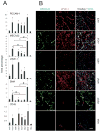Activated forms of VEGF-C and VEGF-D provide improved vascular function in skeletal muscle
- PMID: 19443835
- PMCID: PMC2776655
- DOI: 10.1161/CIRCRESAHA.109.197830
Activated forms of VEGF-C and VEGF-D provide improved vascular function in skeletal muscle
Abstract
The therapeutic potential of vascular endothelial growth factor (VEGF)-C and VEGF-D in skeletal muscle has been of considerable interest as these factors have both angiogenic and lymphangiogenic activities. Previous studies have mainly used adenoviral gene delivery for short-term expression of VEGF-C and VEGF-D in pig, rabbit, and mouse skeletal muscles. Here we have used the activated mature forms of VEGF-C and VEGF-D expressed via recombinant adeno-associated virus (rAAV), which provides stable, long-lasting transgene expression in various tissues including skeletal muscle. Mouse tibialis anterior muscle was transduced with rAAV encoding human or mouse VEGF-C or VEGF-D. Two weeks later, immunohistochemical analysis showed increased numbers of both blood and lymph vessels, and Doppler ultrasound analysis indicated increased blood vessel perfusion. The lymphatic vessels further increased at the 4-week time point were functional, as shown by FITC-lectin uptake and transport. Furthermore, receptor activation and arteriogenic activity were increased by an alanine substitution mutant of human VEGF-C (C137A) having an increased dimer stability and by a chimeric CAC growth factor that contained the VEGF receptor-binding domain flanked by VEGF-C propeptides, but only the latter promoted significantly more blood vessel perfusion when compared to the other growth factors studied. We conclude that long-term expression of VEGF-C and VEGF-D in skeletal muscle results in the generation of new functional blood and lymphatic vessels. The therapeutic value of intramuscular lymph vessels in draining tissue edema and lymphedema can now be evaluated using this model system.
Figures







References
-
- Takahashi H, Shibuya M. The vascular endothelial growth factor (VEGF)/VEGF receptor system and its role under physiological and pathological conditions. Clin Sci (Lond) 2005;109:227–241. - PubMed
-
- Yamazaki Y, Morita T. Molecular and functional diversity of vascular endothelial growth factors. Mol Divers. 2006;10:515–527. - PubMed
-
- Tirziu D, Simons M. Angiogenesis in the human heart: Gene and cell therapy. Angiogenesis. 2005;8:241–251. - PubMed
-
- Karpanen T, Alitalo K. Molecular biology and pathology of lymphangiogenesis. Annu Rev Pathol. 2008;3:367–397. - PubMed
-
- Makinen T, Veikkola T, Mustjoki S, Karpanen T, Catimel B, Nice EC, Wise L, Mercer A, Kowalski H, Kerjaschki D, Stacker SA, Achen MG, Alitalo K. Isolated lymphatic endothelial cells transduce growth, survival and migratory signals via the VEGF-C/D receptor VEGFR-3. EMBO J. 2001;20:4762–4773. - PMC - PubMed
Publication types
MeSH terms
Substances
Grants and funding
LinkOut - more resources
Full Text Sources
Other Literature Sources

